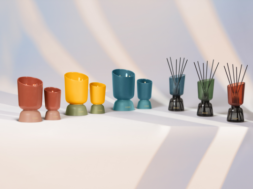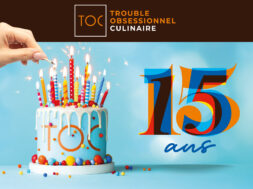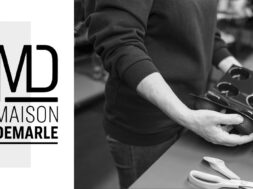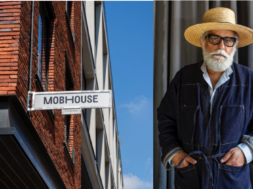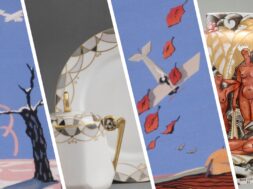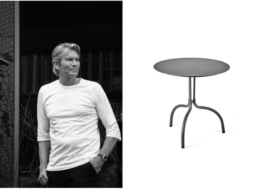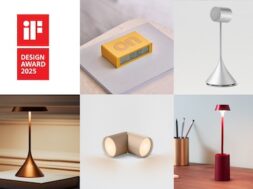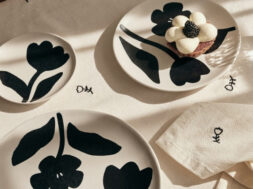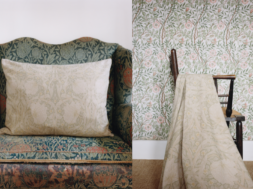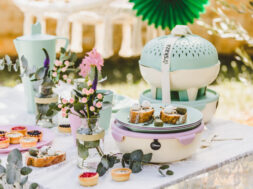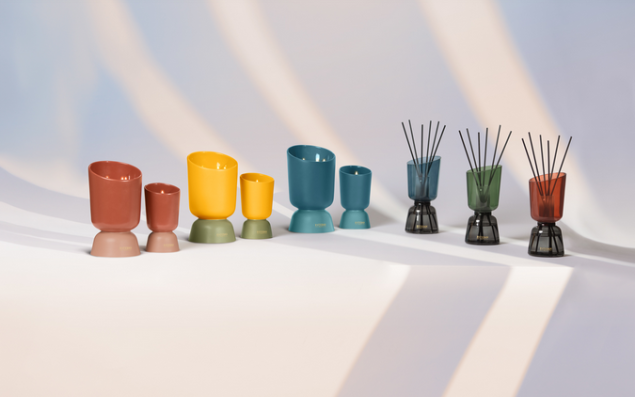
ESTÉBAN, a house of perfumes and emotions, cultivates the art of better living together
For over 40 years, Estéban has elegantly created refined home fragrances: candles, bouquets, sprayers, fragrance trees, mist diffusers, and fragrance mists…Born between Paris and Montpellier, the perfume house has established itself as a leader in the industry while preserving its unique know-how and authentic values. Home Fashion News visited the production site with Laurent Pichon, CEO of Estéban, and Virginie Pruvost, Brand Director (Estéban and Géodésis) and CSR.
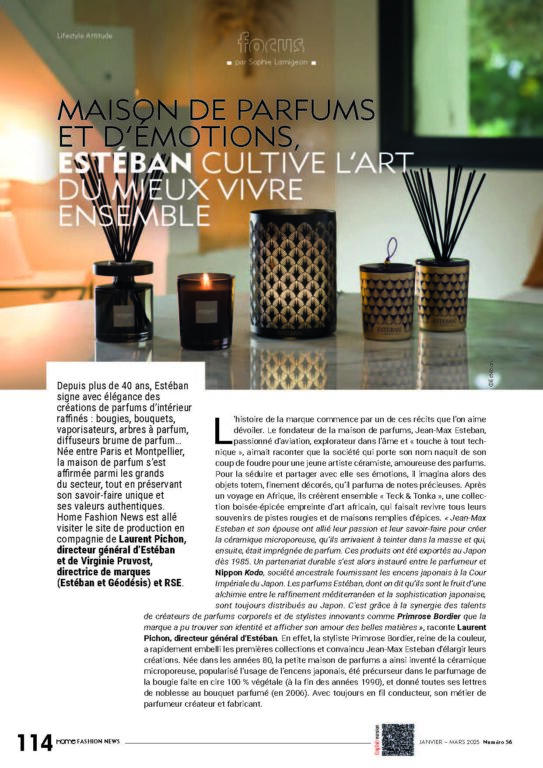
The brand’s story begins with one of those narratives we love to unveil. The founder of the perfume house, Jean-Max Esteban, an aviation enthusiast, an explorer at heart, and a ‘hands-on technical expert’, liked to tell that the company bearing his name was born from a love at first sight for a young ceramic artist, passionate about perfumes. To win her over and share his emotions with her, he conceived decorative totem objects, finely adorned, and infused them with precious scents. After a trip to Africa, they created together « Teck & Tonka, » a woody-spicy collection inspired by African art that brought to life all their memories of red dust paths and spice-filled homes. « Jean-Max Esteban and his wife combined their passion and expertise to create microporous ceramics, which they could colour throughout, and then infuse with fragrance. These products were exported to Japan as early as 1985. A lasting partnership was established between the perfumer and Nippon Kodo, an ancient company supplying incense to the Japanese Imperial Court. The Estéban fragrances, said to be the result of a blend of Mediterranean refinement and Japanese sophistication, are still distributed in Japan today. It is thanks to the synergy of the talents of both body fragrance creators and innovative designers like Primrose Bordier that the brand was able to find its identity and showcase its love for fine materials » explains Laurent Pichon, CEO of Estéban. Indeed, the stylist Primrose Bordier, a master of colour, quickly enhanced the first collections and convinced Jean-Max Esteban to broaden their creations. Founded in the 1980s, this small perfume house thus invented microporous ceramics, popularized the use of Japanese incense, pioneered the fragrancing of candles made from 100% vegetable wax (in the late 1990s), and elevated the scented bouquet to its full glory (in 2006). All the while, staying true to its core profession as both creator and manufacturer of perfumes.
With its desire to place the environment at the heart of its development, Estéban created the first refills for scented candles in 2005. The majority of its products are now « refillable, » with most bottles, packaging, and cases being recyclable. Collection after collection, the brand has reinvented the art of home fragrance and continues to expand in this market.
Estéban’s mission is to create fragrance worlds that are as beautiful to behold as they are elegant to smell. « This means that the visual aspect is just as important as the scent. Estéban therefore stands at the crossroads of two worlds: decoration and fragrance. The very recent ‘Iconic Color’ collection, created in collaboration with designer Tristan Lohner, brings gives a fresh boost to the visual aspect. « It’s our first major initiative with a designer. For us, this collection is a significant commitment to accessible decoration and design« , explains Virginie Pruvost, Brand Director and CSR Director.
A French craftsmanship combined with industrial expertise
Estéban has carved out a place for itself among the greats, while preserving its unique craftsmanship and authentic values. From the expertise of its teams and their passion for fragrance, original creations have emerged that celebrate the art of living together and a love for nature. « The idea is to cultivate the art of better living together, an essential concept of sharing. It’s intrinsic to the fragrance industry, as perfume is a messenger, a means of communication. Since the beginning, the company has been committed to nature and to ‘Made in France.’ Estéban’s craftsmanship is experimental, human-centered« , continues Virginie Pruvost.
Estéban’s production site is located in Lavérune, near Montpellier, the historical birthplace of perfume. More than 99% of the fragranced products are made there and are subjected to ‘fragrancing’ in the brand’s workshops, ensuring full control over the entire production process. In addition to candles, for which the team has particular expertise (that of master candle makers), other materials are worked on-site: bouquets with rattam stems, sprayers, fragranceable wooden pieces, and pre-scented ceramics.
Olfactory innovation
« The two key pillars for creating our products are olfactory innovation and a commitment to nature. Olfactory innovation is approached in two ways: the creation of scents and the support. We have iconic collections featuring amber, cedar, each raw material blended with something different, which creates a signature. You will always find fresh top notes and very distinctive base notes at Estéban: often patchouli, a very prominent wood. The interior fragrances are often designed like a fragrance for oneself. This creative aspect is very important. We are always writing new olfactory stories. The support is the second axis of innovation. We have an extensive range of supports in the brand, which is one of our key differentiators from the competition. We aim to find the gesture that best suits the consumer« . Indeed, to diffuse its exclusive fragrances, filled with boldness and originality, the brand develops its own decorative and refillable products. Estéban was a pioneer in creating refillable candles made from 100% vegetable wax. The company also developed the first ‘fragrance mist diffusers’ designed for fragrance concentrates and invented creative wood-based diffusion products.
Commitment to nature
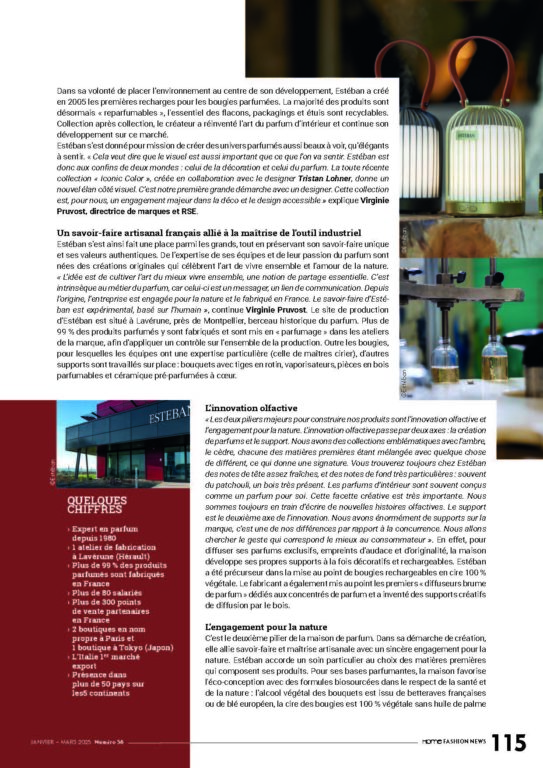
This is the second pillar of the perfume house. In its approach to creation, Estéban combines craftsmanship and artisan mastery with a sincere commitment to nature. Estéban pays special attention to the selection of raw materials that make up its products. For its fragrance bases, the brand favours eco-design with bio-sourced formulas that respect both health and the environment: the plant-based alcohol used in the bouquets comes from French beets or European wheat, while the wax in the candles is 100% plant-based, with no palm oil, primarily sourced from rapeseed. Estéban also uses rattan for the stems of its bouquets, as well as mulberry paper and wood from sustainably managed forests.
« Estéban promotes refillability, which today accounts for nearly half of our business. This is quite positive in terms of our CSR approach, » says the CEO of Estéban. The refillable aspect is very economically attractive for loyal customers who consider the product to offer good value for money. « From a business perspective, Estéban is fortunate to have very loyal customers who come back to purchase refills. It’s worth noting that, due to the return to home life following the Covid crisis, there hasn’t been a major drop in activity as we’ve seen in the home fragrance category. Today, many of our retail partners who have chosen our brand are seeing their sales grow, as people continue to buy their refills. Our customers’ loyalty is due to the quality, reliability of our scents, and the design of our products, » adds Virginie Pruvost.
In the design of its products, Estéban integrates refillability from the outset: ‘Today, the only product that isn’t refillable is the fragrance spray, as the benefits are limited. But when we design a new candle, we first look at how we can make it refillable before finalising it. It’s a constraint for the designers: the product must allow us to use our refills,’ continues Laurent Pichon.
Estéban also prioritises recyclability: when it comes to packaging and bottles, the emphasis is on containers that are fully or predominantly recyclable. The refill bottles for scented bouquets are made from 100% recycled plastic. One of the main challenges in production is reducing waste by limiting excessive packaging.
A well-integrated and mastered craftsmanship expertise.
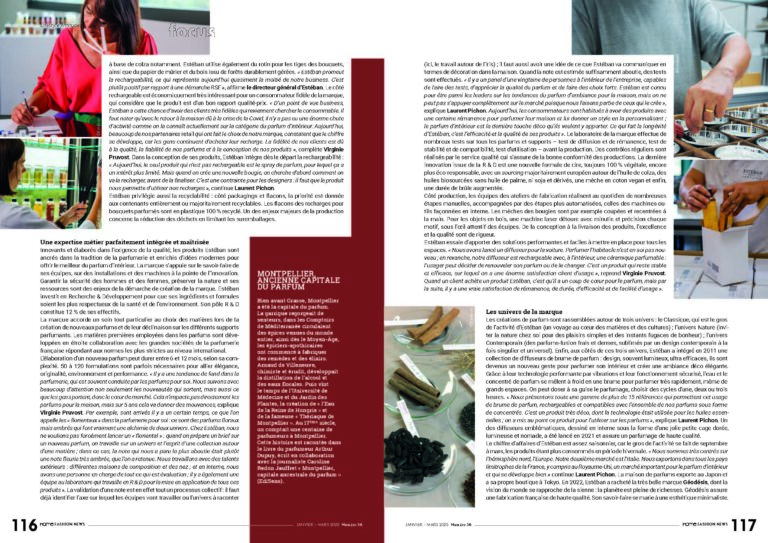
Innovative and crafted with a commitment to quality, Estéban products are rooted in the tradition of perfumery, enriched with modern ideas to offer the best in home fragrance. The brand relies on the expertise of its teams, as well as cutting-edge installations and machinery. Ensuring the safety of its employees, preserving nature and its resources are key aspects of the brand’s creative process. Estéban invests in Research & Development to ensure its ingredients and formulas are as health- and environmentally-friendly as possible. Its R&D department represents 12% of its workforce.
The brand pays particular attention to the selection of materials when creating new fragrances and adapting them to different fragrancing supports. The raw materials used in the perfumes are developed in close collaboration with major French perfumery companies that adhere to the strictest international standards. The development of a new fragrance can take between 6 and 12 months, depending on its complexity. Between 50 and 120 formulations are sometimes required to combine elegance, originality, environmental considerations, and performance. ‘There is an underlying trend in perfumery, often driven by personal fragrances. We pay close attention not only to the latest releases but also to what people are wearing, meaning the heart of the market. This doesn’t directly affect home fragrances, but over five years, it will create trends’, explains Virginie Pruvost. For example, the ‘florientals’ in personal fragrance emerged some time ago: these are floral perfumes with an amber base that truly blend two worlds. At Estéban, we didn’t necessarily want to launch a ‘floriental’: when we prepare a brief for a new fragrance, we focus on a universe and the spirit of a collection around a material. In this case, the note that seemed most developed to us was a very amber floral note, which we selected. We work with external talents: various fragrance houses and perfumers, and internally, we have someone responsible for evaluations. There’s also a team in the lab working on R&D to implement these products« . The validation of a fragrance note is, in fact, a collective process: first, the team must identify the direction they will take or the theme they will explore (in this case, the work around iris); they must also have an idea of how Estéban wants to communicate in terms of home décor. Once the note is considered sufficiently refined, tests are carried out. « There’s a panel of around twenty people within the company who are able to conduct tests, assess the quality of the fragrance, and make strong choices. Estéban is known for being among the leaders in home fragrance trends, but we can’t rely completely on the market since we are part of the process of creating it » explains Laurent Pichon. « Today, consumers are accustomed to products that offer lasting scent when they want to fragrance their home and give it a personalised style; home fragrance is the final decorative touch they want to add. What ensures Estéban’s longevity is the effectiveness and quality of its products. » The brand’s laboratory conducts numerous tests on all fragrances and diffusers – including diffusion and longevity tests, stability and compatibility tests, and usage tests – before production. Regular checks are carried out by the quality department to ensure the conformity of the production. The latest innovation from R&D is a new wax formula, still 100% plant-based, even more eco-friendly, with mostly European-sourced rapeseed oil, bio-sourced oils without palm oil, soy, or derivatives, a vegan cotton wick, and, finally, an extended burn time.
In production, the workshop teams carry out numerous manual steps every day, complemented by more automated stages, with machines and tools crafted in-house. For example, the candle wicks are cut and centered by hand. For wooden objects, a laser machine meticulously and precisely outlines each design, under the careful supervision of the teams. From design to product delivery, excellence and quality are essential.
Estéban strives to offer efficient and easy-to-implement solutions for all spaces. ‘We have launched a diffuser for the car. Scenting the car interior is not new in itself; however, our diffuser is refillable, with a fragranced ceramic inside: the user can choose to renew or change the scent. It’s a product that remains stable and effective, with a high level of customer satisfaction in terms of usage,’ says Virginie Pruvost. When a customer buys an Estéban product, it’s because they have fallen in love with the fragrance, but afterwards, they experience true satisfaction with its longevity, duration, effectiveness, and ease of use.
Estéban strives to provide effective and easy-to-implement solutions for all spaces. « We launched a diffuser for cars. Scenting the car interior is not new; however, our diffuser is refillable and contains a scentable ceramic: the user can choose to renew or change the fragrance. It’s a product that remains stable and effective, with high customer satisfaction », says Virginie Pruvost. « When a customer buys an Estéban product, it’s because they have fallen in love with the fragrance, but afterward, they experience true satisfaction from its longevity, duration, effectiveness, and ease of use ».
The brand’s universes
The fragrance creations are grouped into three universes: the Classic, which represents the core of Estéban’s activity (a journey to the heart of materials and cultures); the Nature universe (bringing nature into the home for simple pleasures and fleeting moments of happiness); and the Contemporary universe (fresh and dense fusion fragrances, enhanced by contemporary design that is both unique and universal). In addition to these three universes, Estéban introduced a collection of fragrance mist diffusers in 2011. Stylish, often luminous and highly effective, they have become a new way to fragrance your home and create an elegant decorative atmosphere. Thanks to their advanced vibration technology and secure operation, the water and fragrance concentrate mix cold into a mist, quickly scenting even large spaces. The fragrance intensity can be adjusted according to the user’s preference, with cycles of one, two, or three hours. ‘We offer an entire range of over 15 references that allow for this fragrance mist use, all refillable and compatible with all of our fragrances in concentrate form. It’s a very decorative product, and the technology, originally used for essential oils, was adapted for our fragrances, explains Laurent Pichon. One of the iconic diffusers, designed in-house as a charming small golden cage, luminous and portable, was launched in 2021 and ensures high-quality fragrance diffusion.
Estéban’s turnover is quite seasonal, with the bulk of activity occurring between September and March, as the products are consumed more during the winter months. « We are very focused on the Northern Hemisphere, particularly Europe. Our second market is Italy. We export to all countries bordering France, including the United Kingdom, a significant market for home fragrances that is developing well« , continues Laurent Pichon. The perfume house also exports to Japan and has its own store in Tokyo. In 2022, Estéban acquired the beautiful brand Géodésis, whose vision aligns closely with its own: the planet is full of riches. Géodésis ensures high-quality French manufacturing. Its craftsmanship blends with a minimalist aesthetic.
« Iconic Color »: The Story of a Collaboration
The exclusive « Iconic Color » collection is the result of a unique collaboration between Estéban and French designer Tristan Lohner. « We asked Tristan Lohner to work on our iconic products and best-sellers, which are our candles and historic fragrances. The goal was to show that we are an accessible brand, not a luxury brand; we want to stay within people’s everyday lives and visually display the sensoriality and quality of the fragrance. The collection is available in several colour variations and two formats: the glass scented bouquet and the ceramic candle, both refillable« , explains Virginie Pruvost. Embodying elegance and modernity, this line reinterprets classic design codes with a contemporary perspective, aimed at enriching our interiors in a sensory way. The designer, who recently left his position as Deputy Director at the RBC Group to create his own agency in Paris, is a strong advocate of accessible design, both elegant and functional. He enjoys drawing inspiration from the purity of forms and the intimate relationship between the object and its user. His creations, full of sensitivity, perfectly align with Estéban’s vision, which aims to make every fragrance a true emotional journey. It is through their shared values – a keen sense of aesthetics, a deep respect for materials, and a responsible approach – that this collection was conceived. It subtly reaffirms Estéban’s premium positioning. This collaboration represents a holistic approach to design, where each object is meant to be a complete emotional experience, both visual and olfactory. « I like to capture the essence of an object through the emotion it evokes« , says Tristan Lohner. This dialogue between the object and the user is expressed through ergonomic shapes that encourage handling, while the transparency of the glass and the tactile softness of the ceramic reveal the essence of Estéban’s iconic fragrances.
Firmly rooted in current trends, the « Iconic Color » collection, with its clean curves and vibrant, bold colours, invites touch and visual experience. With its striking saffron yellow, the depth of cobalt blue, or the understated crimson red, each creation becomes a decorative object that integrates harmoniously into any type of interior. Like a totemic object, the candle, with its beveled shape, enhances the flame reflected in the brilliance of its container. A very decorative item, it comes in two refillable sizes (220 g and 700 g). The scented bouquet consists of two elegant pieces in smoked glass, designed to fit together. The stems are designed not to touch the glass for optimal fragrance diffusion. This collection stands out with six iconic Estéban fragrances, which awaken the senses while adding a refined olfactory signature to any interior: Teck & Tonka, Amber, Neroli, Pur Lin, Black Fig, and Cashmere Iris. « This collaboration with Tristan Lohner marks an important step in our desire to combine design and fragrance to offer unique experiences. With « Iconic Color », we reaffirm our commitment to creating objects that combine aesthetics and emotion, » concludes Laurent Pichon. In 2024, Tristan Lohner received the « French Design 100 » award, recognising projects of objects and spaces that showcase French creativity internationally.
The « Iconic Color » collection will be available from February 2025 in Estéban’s two boutiques in France, located in the iconic Marais and Saint-Germain-des-Prés districts in Paris. It will also be available in the brand’s partner stores and on its website www.esteban.fr. Thanks to the recognised quality and originality of its products, Estéban is distributed in over 2,000 partner retail outlets (corners, chains, department stores, boutiques). The brand is present on all five continents.
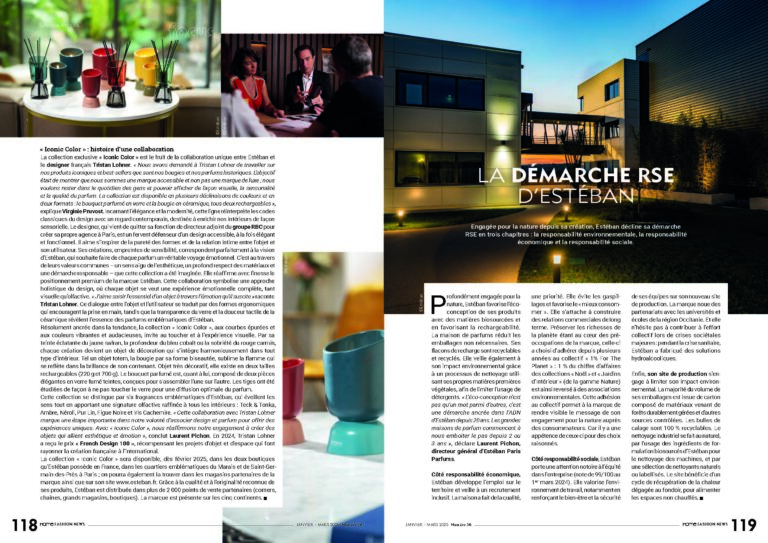
ESTÉBAN’S CSR APPROACH
Deeply committed to nature, Estéban promotes eco-design for its products by using bio-sourced materials and prioritising refillability. The perfume house also reduces unnecessary packaging. Its refill bottles are recyclable and made from recycled materials. It also pays close attention to its environmental impact through a cleaning process that uses its own plant-based raw materials, thereby limiting the use of detergents. « Eco-design is not just another buzzword; it has been embedded in Estéban’s DNA for the past 20 years. Major perfume houses have started following our lead in the last two or three years« , says Laurent Pichon, CEO of Estéban Paris Parfums.
In terms of economic responsibility, Estéban fosters local employment and ensures inclusive recruitment. The house has made quality a priority. It avoids waste and promotes « better consumption. » It is committed to building long-term business relationships. With preserving the planet’s resources at the heart of its concerns, the brand has chosen to join the « 1% For The Planet » collective for several years: 1% of the turnover from the « Christmas » and « Indoor Gardens » collections (from the Nature range) is donated to environmental associations. This partnership with the collective allows the brand to make its commitment to nature visible to consumers, as there is a growing appetite for sustainable choices.
In terms of social responsibility, Estéban places significant emphasis on equity within the company (with a score of 99/100 as of March 1, 2024). The brand values the working environment, particularly by enhancing the well-being and safety of its teams at its new production site. The company has established partnerships with universities and schools in the Occitanie region. Additionally, it has not hesitated to contribute to collective efforts during major societal crises: during the health crisis, Estéban produced hand sanitiser solutions.
Finally, its production site is committed to reducing its environmental impact. The majority of its packaging volume comes from cardboard made from materials sourced from sustainably managed forests and other controlled sources. The packaging bubbles are 100% recyclable. Industrial cleaning is done naturally, using Estéban’s own bio-based ingredients for machine cleaning, along with a selection of natural or certified cleaners. The site also benefits from a heat recovery system that captures heat from the smelting process to heat non-heated areas.
Source : January 2025 / HFN56
